

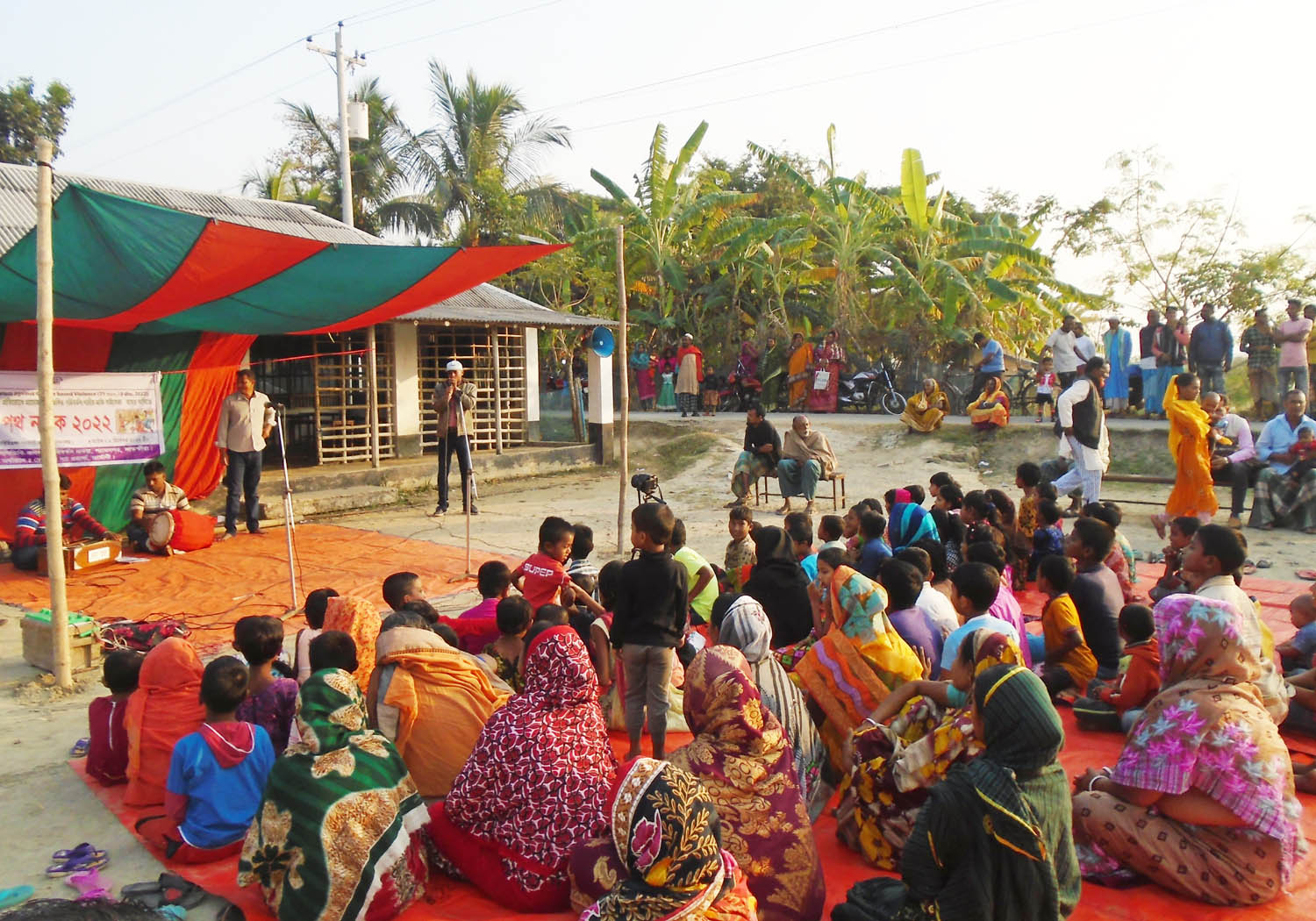



In a region where energy security poses real challenges, but sunlight is not in short supply, solar electricity seems an obvious solution for much of Africa. But the answer isn’t as simple as that.
Installing vast arrays of photovoltaic (PV) panels often means clearing swathes of land to bare soil. This has an impact on land sustainability, affecting soil stability, water retention, carbon sequestration and biodiversity. And there is often competition for land, which is also needed for food production.
But a new trial planting crops beneath the panels has shown some promising results in Eastern Africa.
Known as agrivoltaics, the system is about more than just overcoming land use conflict. It uses the shade provided by the PV set-up, as well as rain water harvesting, to provide a more nurturing environment for crops than if they were planted in open fields.
The first agrivoltaic system in East Africa opened in early 2022 in Insinya, Kenya, through a combined effort from the Universities of Sheffield, York and Teesside in the UK, the Stockholm Environment Institute, World Agroforestry, the Centre for Research in Energy and Energy Conservation, and the African Centre for Technology Studies.
Instead of being mounted close to the ground like traditional solar arrays, these panels are constructed several metres high, with gaps in between them. This allows crops to be grown underneath, protected from heat stress and water loss.
The favourable growing conditions also mean that a greater range of higher value crops can be grown, improving farmer incomes in disadvantaged rural areas. And areas which were previously unviable as growing environments may now be used.
Because of this, the team says the system is akin to “harvesting the sun twice”.

In Africa’s energy mix (present and projected), solar will be the dominant energy source by 2100. Image: Brookings
Professor Sue Hartley, project lead and Vice-President for Research at the University of Sheffield, said: “This project is an excellent example of how ground-breaking interdisciplinary research can deliver really significant benefits to communities. It’s exciting to see this research being showcased in Kenya in this way, and I’m confident the event will stimulate even greater interest in the potential of this novel technology.”
Africa’s renewable energy potential is 1,000 greater than it’s projected electricity demand by 2040, according to the International Renewable Energy Agency (IRENA). By that date, the share of renewables in southern and eastern Africa could grow to 63%, up from a fifth in 2016.

Africa has more than enough renewable energy potential to meet its future demand. Image: IRENA
Currently, more than half of the continent’s energy supply comes from fossil fuels, which also make up 40% of its exports.

Mohammad Mostafa, a farmer in the low-lying deltas of southwestern Bangladesh, has revived his forefathers’ farming practice of growing crops on floating rafts as rising seas and storm flooding threaten more and more farmland.
With prolonged waterlogging posing an increasing threat to families growing their own food, more have turned to using the rafts as secure platforms to grow vegetables and fruit including cucumbers, radishes, bitter gourds, papayas and tomatoes. Most are sold as saplings.
The 200-year-old technique was initially adopted by farmers in the region during the flooding season, which used to last about five months each year. But nowadays the area remains underwater for eight to 10 months and more land is being flooded, reports Reuters.
“These days, the land remains under water for a longer time. This ancient technique has helped us to earn a living,” said 42-year-old Mostafa, as he planted balls of seedlings on floating beds.
“My father and forefathers all used to do this. But the work is not that easy. So, at first I tried to earn as a fruit vendor but ended up in debt,” said Mostafa, the sole breadwinner in his six-member family. “I tried my luck at floating farming five years ago and that made a great difference to my life.”
The approach, now practised by some 6,000 subsistence farmers across the swampy southwest, may prove crucial as climate change sends sea levels higher and makes the monsoons more erratic.
Digbijoy Hazra, an agriculture official in the Nazirpur sub-district of Pirojpur, said that the number had risen from around 4,500 five years ago.
Floating farms now cover a total 157 hectares (388 acres) in Pirojpur district, with 120 hectares in Nazirpur that expanded from 80 hectares five years ago.
“It requires less space than conventional farming and does not need pesticides,” Hazra said. “When we’re fighting … the impact of global warming, floating farming could be the future.”
Low-lying Bangladesh is considered among the most climate-vulnerable countries, with the impact of rising waters compounded by storms, floods and erosion.
The climate impact is being compounded by natural factors, such as tectonic shifts that are causing the land beneath to sink, and upstream dams holding back silt that would replenish the eroding delta.
Between 2000 and 2019, Bangladesh was ranked seventh in a list of countries hit hardest by climate change, according to the Global Climate Risk Index 2021 produced by non-profit Germanwatch.
“Because it is the largest delta in the world … a huge portion of Bangladesh’s land area experiences frequent flooding, especially flash floods along with river erosion,” the Asian Development Bank said in a 2021 report.
Bangladesh is also frequently hit by cyclones that barrel up the Bay of Bengal, while global warming makes rainfall patterns increasingly erratic. More than a quarter of Bangladesh’s population of 165 million live in the coastal zone.
Rising sea levels and coastal erosion could cause Bangladesh to lose 17% of its land surface and 30% of its food production by 2050, according to a 2019 International Monetary Fund report.
Navigating a boat along one of the country’s countless waterways, Mostafa said he is now able to feed his family “without asking for help.”
The profit margins, however, have been shrinking as costs rise, he added. This year, he spent about 4,500 taka ($43) for a boatload of water hyacinths weighing about 1.2 tonnes to weave into new rafts for the year. Last year, the cost was just 1,000 taka.
The rafts, which take two months to make, are typically around 6 metres long and 1 metre wide, but can be several times that length, farmers said. They need to be replaced with new ones after three to four months.
Mohammad Ibrahim, another farmer in the area, said the floating beds allow him to grow more crops reliably.
“Water levels are rising. I still can remember I used to play football in the land that now goes underwater during the normal tide,” the 48-year-old said as he sold gourd saplings that he grew on the floating beds on a boat.
The effort is not without cost.
His wife Murshida Begum, 35, said she works more than eight hours a day making balls of seedlings that are planted on the rafts, but the hyacinths often cause itching and sores across her palms and fingers.
Kajol Begum, a 30-year-old mother of two daughters, said: “The work is so hard and painful. I can’t sleep at night due to waist pain. But what else will I do when water is everywhere most of the time?”
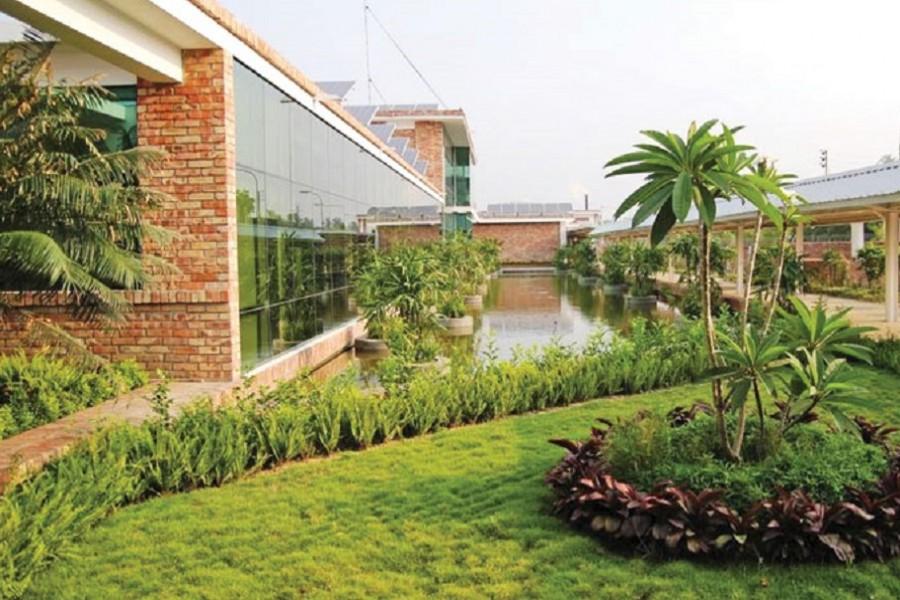
Bangladesh has strengthened its position as the global leader in green apparel factories, as the country now has 176 such factories with USGBC’s LEED certification.
Three more Bangladeshi garment factories have achieved green building certification from the United States Green Building Council (USGBC) in the platinum category, reports UNB.
The factories are CA Knitwear in the Bhobanipur area of Gazipur, Silken Sewing in the Baniarchala area of the district, and Sultana Sweaters in the Meherabari area of Mymensingh.
Some 550 are also in the pipeline to get the USGBC Leadership in Environmental and Energy in Design (LEED) – a globally recognised symbol of sustainability achievement and leadership – certification, Bangladesh Garment Manufacturers and Exporters Association (BGMEA) Director Mohiuddin Rubel said.
Of them, 76 are platinum-rated, 105 gold-rated, 10 silver-rated and four are only certified, he added.
Bangladesh has the highest number of green garment buildings, where 57 are platinum-rated, 105 gold-rated, 10 silver-rated, and four have no rating. Vietnam and Indonesia come next in the list of green factories.
USGBC honours factories based on several criteria – transformation performance, energy, water, and waste management. The best performers are rated with platinum, followed by gold and silver.

A new report published by RenewableUK shows that the total pipeline of floating offshore wind projects has more than doubled in the past 12 months in terms of capacity worldwide, from 91GW a year ago to 185GW now.
A new report published by RenewableUK shows that the total pipeline of floating offshore wind projects has more than doubled in the past 12 months in terms of capacity worldwide, from 91GW a year ago to 185GW now.
The number of projects has increased globally during that time from 130 to 230. The pipeline includes projects at any stage: operational, under construction, approved, in the planning system or at an early stage of development.
The UK’s pipeline has increased from 23GW a year ago to over 33GW, and from 29 projects to 51, which are being developed in the North Sea (Scottish and English waters), Celtic Sea and the North Atlantic Ocean.
Within the global 185GW pipeline, 121MW is fully commissioned over 9 projects in 7 countries. 96MW is under construction, 288MW is consented or in the pre-construction phase, 31GW is in planning or has a lease agreement and 153GW is in early development or is in the leasing process.
107GW (58%) of floating capacity is being developed in Europe. 33.3GW (18%) of the global floating portfolio is in the UK, of which 29GW is in Scottish waters.
Outside Europe, leasing areas off the west coast of the USA, project proposals off the south east coast of Australia, and South Korea make up the majority of the rest of the capacity.
The report states that by the end of 2030, floating wind capacity could reach 11GW in the UK, 31GW in Europe and 41GW globally.
It also notes that demand for floating foundations is expected to ramp up fast, with the potential for nearly 1,000 floating foundations to be installed in UK waters by the end of 2030. Globally 3,200 floating foundations could be installed by the end of the decade.
RenewableUK’s CEO Dan McGrail said: “The growth of floating offshore wind is surging ahead at a phenomenal rate year on year around the world. We’re proud that the UK is a global leader in this innovative technology with nearly a fifth of the total pipeline – significantly greater than any other country.
The EnergyPulse report, which is available to RenewableUK members, is being released at RenewableUK’s Floating Offshore Wind 2022 conference and exhibition in Aberdeen today.

Recent CDP data presents frightful statistics of the state of our climate. 80% of cities are facing extreme conditions such as exorbitant heat to damaging floods in 2022. However, on a positive note, their press release stated that 63% of cities are participating in citizen-focused climate action which has resulted in better health, increased job opportunity, biodiversity and social inclusion.

As the world searches for ways to counter the climate crisis, experts are turning to food systems for solutions. Research from the IPCC shows that food loss and waste is responsible for a staggering 8-10 per cent of global greenhouse emissions.
So, where does this food loss come from?
“Food loss and waste occurs at every stage of the supply chain but is concentrated on the farm and in the home,” says Clementine O’Connor, a food systems expert with the United Nations Environment Programme (UNEP). “The middle of the supply chain generates comparatively small volumes of food waste but has resounding influence over how food is grown, purchased and eaten.”
O’Connor’s comments came just ahead of the International Day of Awareness of Food Loss and Waste, which falls on 29 September. The day is designed to push governments, businesses and consumers to address a prime shortcoming of the world’s food systems, which UN Secretary-General António Guterres said are “putting historic pressure on our natural resources, climate and natural environment.”
Reforming food systems
The UNEP Food Waste Index Report 2021 revealed that around 931 million tonnes of food waste was generated in 2019, 61 per cent of which came from households, 26 per cent from food service and 13 per cent from retail.
Experts say there are some simple ways to stem those losses.
Consumers can help reduce the amount of food lost in transport by buying locally grown produce, including at places like farmers’ markets. Supporting local farms also fosters food security and can help domestic agriculturalists adapt to climate change,O’Connor says.
Growing your own food can help you enjoy produce at peak ripeness, but systemic changes, at country and city-level, are needed to dramatically reduce food waste, O’Connor added.
Urban solutions
About 70 per cent of food consumption occurs at the urban level. Experts say city governments can help create circular food systems by raising awareness about food loss, promoting urban agriculture, providing free food waste recycling services, and banning organic waste from landfills.
With food prices 34 per cent higher than this time last year, consumers also have a powerful incentive to reduce food waste. Yet new research from Unilever and the non-governmental organization Wrap shows that food waste costs families with children 780 pounds sterling per year in the United Kingdom and US$1,900 per year in the United States. “Alongside reducing energy and water usage and rethinking transportation, cutting food waste is an important way we can all cut our costs,” O’Connor says.
An estimated 3.1 billion people worldwide do not have a healthy diet, and some 828 million people go hungry. Since 2019, the number of people experiencing hunger as a result of the pandemic has increased by more than 100 million. All of this means there is an urgent need to accelerate action to reduce food loss and waste.
Signs of hope
The good news is that progress is being made. The Courtauld Commitment has supported a 27 per cent reduction in food waste since 2007 in the United Kingdom. Similar partnerships are advancing rapidly in Mexico, South Africa, Indonesia, Australia, and parts of the United States.
For those who want to make a difference, O’Connor says, the transformation can happen at the dinner table. “Eat your leftovers. Buy and cook the right amount –small shops can help in purchasing more accurate quantities and using a cup measure can help get portion sizes right.”
Other practical steps include scheduling a day to cook up anything hiding in the fridge before restocking and sharing excess food with friends and neighbours, especially before leaving for a trip. Or growing fruits and vegetables, pickling surplus, composting inedible scraps and asking local governments about separate food waste collections.
Dietary changes can help too, O’Connor says. “Eating a wide variety of plants is good for your health and the planet – thirty different kinds per week is my current objective.”
In December, the world will gather for the UN Biodiversity Conference (COP15) in Montreal to strike a landmark agreement to guide global actions on biodiversity through 2030.
The negotiations offer a unique opportunity to transform agriculture and food systems to benefit people and the planet through the sustainable use and conservation of nature.
For more information about food loss and waste, contact Clementine O’Connor: clementine.oconnor@un.org
About the International Day of Awareness of Food Loss and Waste
The International Day of Awareness of Food Loss and Waste observed for the third time on 29 September 2022 will make a clear call to action for public and private entities, from across the food system, and consumers, to work together to cut food loss and waste to enhance the efficient use of natural resources, mitigate climate change, and support food security and nutrition.

It is the variety of life on Earth, in all its forms and all its interactions. If that sounds bewilderingly broad, that’s because it is. Biodiversity is the most complex feature of our planet and it is the most vital. “Without biodiversity, there is no future for humanity,” says Prof David Macdonald, at Oxford University.
The term was coined in 1985 – a contraction of “biological diversity” – but the huge global biodiversity losses now becoming apparent represent a crisis equalling – or quite possibly surpassing – climate change.
More formally, biodiversity is comprised of several levels, starting with genes, then individual species, then communities of creatures and finally entire ecosystems, such as forests or coral reefs, where life interplays with the physical environment. These myriad interactions have made Earth habitable for billions of years.
A more philosophical way of viewing biodiversity is this: it represents the knowledge learned by evolving species over millions of years about how to survive through the vastly varying environmental conditions Earth has experienced. Seen like that, experts warn, humanity is currently “burning the library of life”.
For many people living in towns and cities, wildlife is often something you watch on television. But the reality is that the air you breathe, the water you drink and the food you eat all ultimately rely on biodiversity. Some examples are obvious: without plants there would be no oxygen and without bees to pollinate there would be no fruit or nuts.
Others are less obvious – coral reefs and mangrove swamps provide invaluable protection from cyclones and tsunamis for those living on coasts, while trees can absorb air pollution in urban areas.
Others appear bizarre – tropical tortoises and spider monkeys seemingly have little to do with maintaining a stable climate. But the dense, hardwood trees that are most effective in removing carbon dioxide from the atmosphere rely on their seeds being dispersed by these large fruit-eaters.
When scientists explore each ecosystem, they find countless such interactions, all honed by millions of years of evolution. If undamaged, this produces a finely balanced, healthy system which contributes to a healthy sustainable planet.
The sheer richness of biodiversity also has human benefits. Many new medicines are harvested from nature, such as a fungi that grows on the fur of sloths and can fight cancer. Wild varieties of domesticated animals and crops are also crucial as some will have already solved the challenge of, for example, coping with drought or salty soils.
If money is a measure, the services provided by ecosystems are estimated to be worth trillions of dollars – double the world’s GDP. Biodiversity loss in Europe alone costs the continent about 3% of its GDP, or €450m (£400m), a year.
From an aesthetic point of view, every one of the millions of species is unique, a natural work of art that cannot be recreated once lost. “Each higher organism is richer in information than a Caravaggio painting, a Bach fugue, or any other great work,” wrote Prof Edward O Wilson, often called the “father of biodiversity”, in a seminal paper in 1985.
Mind-bogglingly diverse. The simplest aspect to consider is species. About 1.7 million species of animals, plants and fungi have been recorded, but there are likely to be 8-9 million and possibly up to 100 million. The heartland of biodiversity is the tropics, which teems with species. In 15 hectares (37 acres) of Borneo forest, for example, there are 700 species of tree – the same number as the whole of North America.
Recent work considering diversity at a genetic level has suggested that creatures thought to be a single species could in some cases actually be dozens. Then add in bacteria and viruses, and the number of distinct organisms may well be in the billions. A single spoonful of soil – which ultimately provides 90% of all food – contains 10,000 to 50,000 different types of bacteria.
The concern is that many species are being lost before we are even aware of them, or the role they play in the circle of life.
Very. The best studied creatures are the ones like us – large mammals. Tiger numbers, for example, have plunged by 97% in the last century. In many places, bigger animals have already been wiped out by humans – think dodos or woolly mammoths.
The extinction rate of species is now thought to be about 1,000 times higher than before humans dominated the planet, which may be even faster than the losses after a giant meteorite wiped out the dinosaurs 65m years ago. The sixth mass extinction in geological history has already begun, according to some scientists.
Lack of data means the “red list”, produced by the International Union for Conservation of Nature, has only assessed 5% of known species. But for the best known groups it finds many are threatened: 25% of mammals, 41% of amphibians and 13% of birds.
Species extinction provides a clear but narrow window on the destruction of biodiversity – it is the disappearance of the last member of a group that is by definition rare. But new studies are examining the drop in the total number of animals, capturing the plight of the world’s most common creatures.
The results are scary. Billions of individual populations have been lost all over the planet, with the number of animals living on Earth having plunged by half since 1970. Abandoning the normally sober tone of scientific papers, researchers call the massive loss of wildlife a “biological annihilation” representing a “frightening assault on the foundations of human civilisation”.
Humans may lack gills but that has not protected marine life. The situation is no better – and perhaps even less understood – in the two-thirds of the planet covered by oceans. Seafood is the critical source of protein for more than 2.5 billion people but rampant overfishing has caused catches to fall steadily since their peak in 1996 and now more than half the ocean is industrially fished.
More than 95% of known species lack a backbone – there are about as many species in the staphylinidae family of beetles alone as there are total vertebrates, such as mammals, fish and birds. Altogether, there are at least a million species of insect and another 300,000 spiders, molluscs and crustaceans.
But the recent revelation that 75% of flying insects were lost in the last 25 years in Germany – and likely elsewhere – indicates the massacre of biodiversity is not sparing creepy crawlies. And insects really matter, not just as pollinators but as predators of pests, decomposers of waste and, crucially, as the base of the many wild food chains that support ecosystems.
“If we lose the insects then everything is going to collapse,” says Prof Dave Goulson of Sussex University, UK. “We are currently on course for ecological Armageddon.”
Even much-loathed parasites are important. One-third could be wiped out by climate change, making them among the most threatened groups on Earth. But scientists warn this could destabilise ecosystems, unleashing unpredictable invasions of surviving parasites into new areas.
We are, particularly as the human population rises and wild areas are razed to create farmland, housing and industrial sites. The felling of forests is often the first step and 30m hectares – the area of the Britain and Ireland – were lost globally in 2016.
Poaching and unsustainable hunting for food is another major factor. More than 300 mammal species, from chimpanzees to hippos to bats, are being eaten into extinction.
Pollution is a killer too, with orcas and dolphins being seriously harmed by long-lived industrial pollutants. Global trade contributes further harm: amphibians have suffered one of the greatest declines of all animals due to a fungal disease thought to be spread around the world by the pet trade. Global shipping has also spread highly damaging invasive species around the planet, particularly rats.
The hardest hit of all habitats may be rivers and lakes, with freshwater animal populations in these collapsing by 81% since 1970, following huge water extraction for farms and people, plus pollution and dams.
Yes – nothing on Earth is experiencing more dramatic change at the hands of human activity. Changes to the climate are reversible, even if that takes centuries or millennia. But once species become extinct, particularly those unknown to science, there’s no going back.
At the moment, we don’t know how much biodiversity the planet can lose without prompting widespread ecological collapse. But one approach has assessed so-called “planetary boundaries”, thresholds in Earth systems that define a “safe operating space for humanity”. Of the nine considered, just biodiversity loss and nitrogen pollution are estimated to have been crossed, unlike CO2 levels, freshwater used and ozone losses.
Giving nature the space and protection it needs is the only answer. Wildlife reserves are the obvious solution, and the world currently protects 15% of land and 7% of the oceans. But some argue that half the land surface must be set aside for nature.
However, the human population is rising and wildlife reserves don’t work if they hinder local people making a living. The poaching crisis for elephants and rhinos in Africa is an extreme example. Making the animals worth more alive than dead is the key, for example by supporting tourism or compensating farmers for livestock killed by wild predators.
But it can lead to tough choices. “Trophy hunting” for big game is anathema for many. But if the shoots are done sustainably – only killing old lions, for example – and the money raised protects a large swath of land, should it be permitted?
We can all help. Most wildlife is destroyed by land being cleared for cattle, soy, palm oil, timber and leather. Most of us consume these products every day, with palm oil being found in many foods and toiletries. Choosing only sustainable options helps, as does eating less meat, particularly beef, which has an outsized environmental hoofprint.
Another approach is to highlight the value of biodiversity by estimating the financial value of the ecosystem services provided as “natural capital”. Sometimes this can lead to real savings. Over the last 20 years, New York has spent $2bn protecting the natural watershed that supplies the city with clean water. It has worked so well that 90% of the water needs no further filtering: building a water treatment plant instead would have cost $10bn.
Locating the tipping point that moves biodiversity loss into ecological collapse is an urgent priority. Biodiversity is vast and research funds are small, but speeding up analysis might help, from automatically identifying creatures using machine learning to real-time DNA sequencing.
There is even an initiative that aims to create an open-source genetic database for all plants, animals and single-cell organisms on the planet. It argues that by creating commercial opportunities – such as self-driving car algorithms inspired by Amazonian ants – it could provide the incentive to preserve Earth’s biodiversity.
However, some researchers say the dire state of biodiversity is already clear enough and that the missing ingredient is political will.
A global treaty, the Convention on Biological Diversity (CBD), has set many targets. Some are likely to be reached, for example protecting 17% of all land and 10% of the oceans by 2020. Others, such as making all fishing sustainable by the same date are not. The 196 nations that are members of the CBD next meet in Egypt in November.
In his 1985 text, Prof E O Wilson, concluded: “This being the only living world we are ever likely to know, let us join to make the most of it.” That call is more urgent than ever.
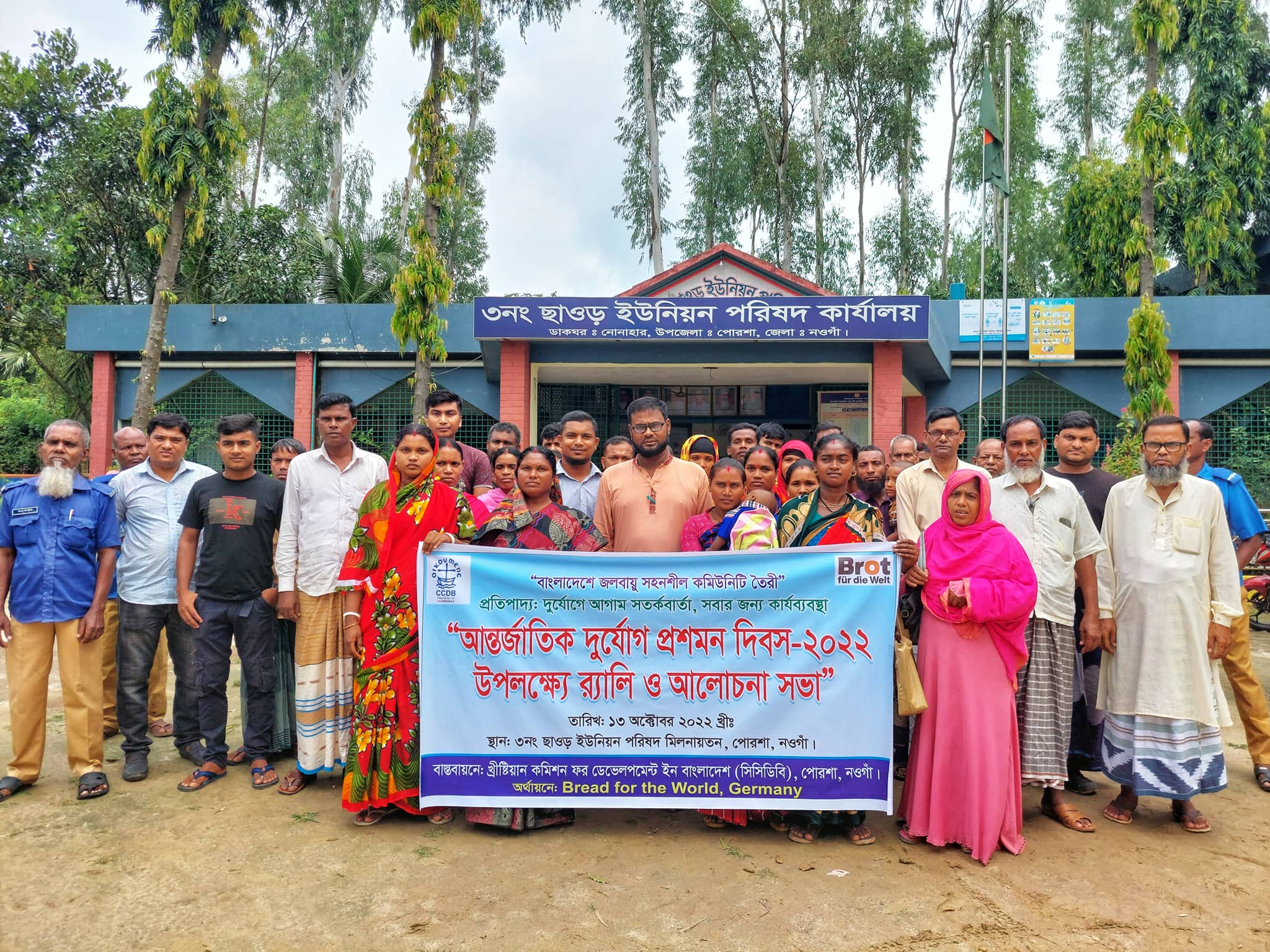
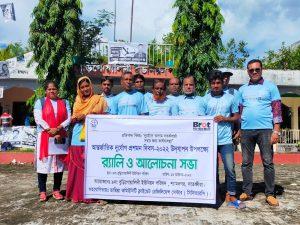

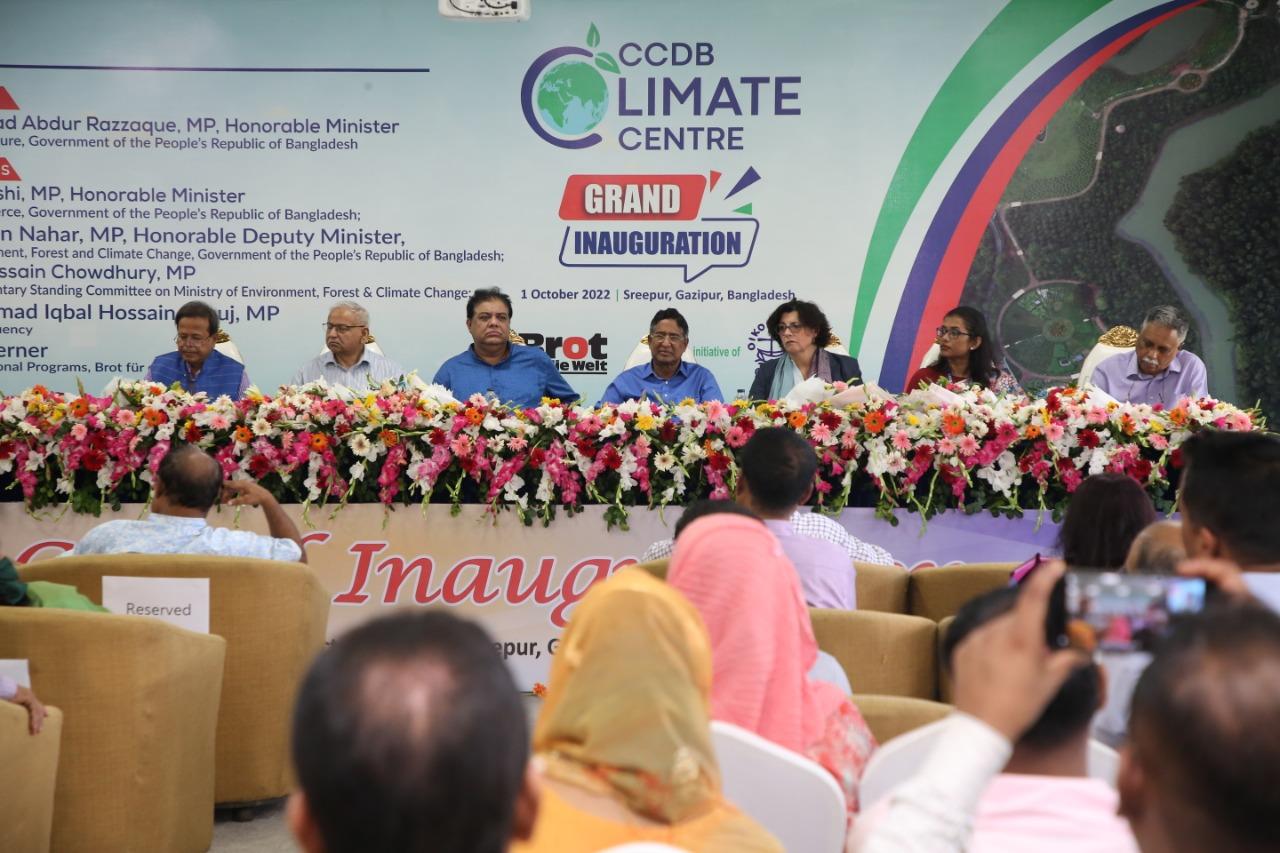
After 10 years of planning and construction, the door of the CCDB Climate Centre in Sreepur was unlocked. The Christian Commission for Development in Bangladesh (CCDB) inaugurated its Climate Centre on 1st October 2022 at Sreepur, Gazipur, Bangladesh. It has been developed as a climate hub for innovation and collaborative action to serve climate-vulnerable communities. The Centre’s 12 ha climate park features Bangladesh’s main ecosystems and almost 100 climate adaptation and renewable energy solutions. The learning centre offers exhibition, training and conference facilities.
The ceremony was inaugurated by Dr. Muhammad Abdur Razzaque, MP, Honorable Minister, Ministry of Agriculture, Government of the People’s Republic of Bangladesh; Mr. Tipu Munshi, MP, Honorable Minister, Ministry of Commerce; Mr. Saber Hossain Chowdhury, MP, Chairman, Parliamentary Standing Committee on Ministry of Environment, Forest & Climate Change; Mr. Iqbal Hossain Sabuj, MP, Gazipur-3 Constituency; Ms. Petra Berner, Director International Programs of ‘Brot für die Welt’ (Bread for the World), Germany; Mr. David A. Halder, Chairman of CCDB Commission; Ms. Juliate Keya Malakar, Executive Director of CCDB, Dr. Saleemul Huq, Director, ICCCAD and Senior Associate, IIED and Dr. Ainun Nishat, Professor Emeritus, Advisor, C3ER, Brac University.
“It is a moment of dream come true for the Christian Commission for Development in Bangladesh (CCDB) on this October 1. It is our dream that this Centre will now start to support us, the communities we work with, and the country in shaping our common future in climate prosperity, climate resilience and towards zero carbon emission pathways”, said Ms. Juliate Keya Malakar, the Executive Director of CCDB.
At the beginning of the ceremony, David A. Halder, Chairman of CCDB Commission, welcomed everyone to the program and the Climate Centre. He expressed his hope that this centre will help the most vulnerable people of our country and make them climate resilient.
In the ceremony, the chief guest Dr. Muhammad Abdur Razzaque, in his speech said, “With or without climate change Bangladesh is extremely vulnerable to natural disasters. Bangladesh Government is trying to gain food security to fight against these adverse effects of climate change.”
Mr. Iqbal Hossain Sabuj, MP, Gazipur-3 Constituency said, ‘This centre will help the young generation to know about the countries that are causing climate change and they will learn how to fight against this adverse effects.”
Professor Ainun Nishat, a pioneering expert in climate change in Bangladesh and the advisor of CCDB Climate Centre said, “Climate disaster will increase in an unpredictable way so we should bring cutting edge technology and build up the capacity to utilize that and become resilient.”
Leading global climate scientist Dr. Saleemul Huq said ‘There are 3 elements of this Climate Centre- A learning centre for the young people, bringing all the stakeholders together and together Bangladesh can become a leader to tackle the climate change and it’s effects and a centre where people can co-operate and learn for each-other.’
Ms Petra Berner, Director International Programs, Brot für die Welt, Germany said, “Stopping climate change and managing its impacts requires transformative action based on networking local knowledge with research and development. This is what the Climate Centre stands for and we are happy to become a partner in this venture”
Ms. Juliate Keya Malakar, the Executive Director of CCDB, welcomed everyone to the Climate Centre and gave the vote of thanks to all.
“We envision this facility to become a ‘center of climate excellence’ that serves as a knowledge hub and as a common platform for cooperation and collaborative action that can be used by diverse stakeholders be it practitioners, academia, public sector or private sector, be it from Bangladesh or from abroad. What should unite us is to find solutions against climate change threats, and to serve the most vulnerable people,” said Mr. Foezullah Talukder, Head of the CCDB Climate Change Program.
“The CCDB Climate Centre opens its doors not only for capacity building events, researchers or conferences. It is open to everyone, who wants to learn about Bangladesh’s climatic zones, how they are affected by climate change, and what are good practices of adaptation and the use of renewable energy. We invite families, school classes, students, companies, or communities to visit us and enjoy the beauty of the place,” said Ms. Juliate Keya Malakar.
The Christian Commission for Development in Bangladesh (CCDB) is a national NGO established in 1973, envisioning a just and caring society where people live in peace, with dignity and harmonious relationship with all God’s creation. CCDB is supporting tens thousands of poor households in 28 districts of Bangladesh. Experiencing the devastating consequences of climate disasters, CCDB started to address climate change in 2008.